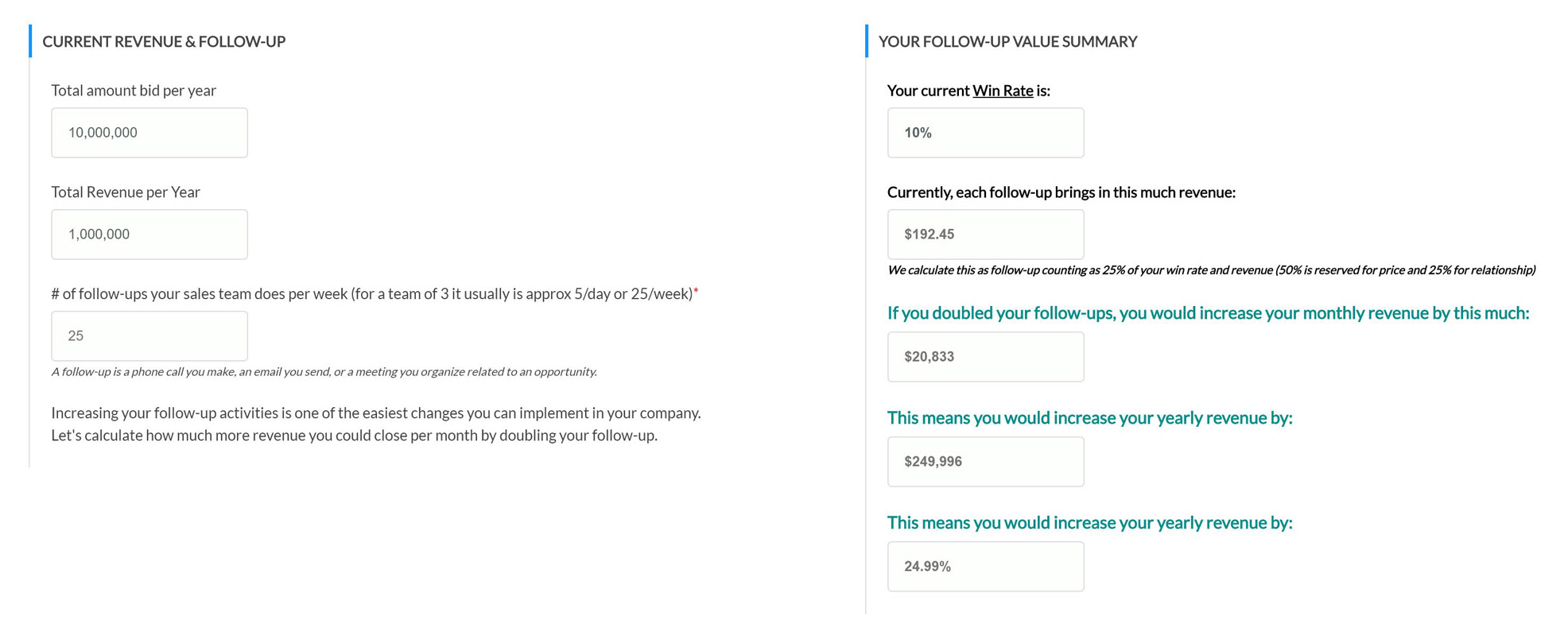Follow up value is not something readily apparent, but with the help of a follow up value calculator, we can associate a monetary value to it.
We can also estimate how much more revenue we could bring into our companies by simply increasing the number of follow-ups we perform every week.
Follow-up is one of the more important factors that influence a construction company’s win rate with an importance of about 20%-25%. Other factors with more weight are of course price and relationship you have with the client you are bidding.
The follow-up calculator shows us just how important follow-up can be when looking to increase our win rate and revenue. And the revenue increase can’t be ignored when quantified.
The Follow Up Value.
How much money are we leaving on the table when we miss a follow-up?
This follow-up calculator shows you how much money you leave on the table when you miss a follow-up. It attaches a value to follow up so we can quantify the importance of follow-up activities.
The follow up value calculator assumes that there are three factors that influence our win rate: price, relationship, and follow-up. Each factor has a different rate of influence on your win rate. For example, we assume: 50% for the price, 25% for the relationship, and 25% for the follow-up.

How to Use Follow Up and Follow Up Value to Increase Revenue
While follow-up is one of the activities we leave last on our list, follow-up has great value. And the follow-up value goes beyond increasing win rate. It helps companies identify reasons for losing bids or projects. Follow-up value can also highlight possible issues with implementation or installation. It ultimately helps increase revenue.
The solution to leverage follow-up to increase revenue is to:
- outline your follow-up process
- find and implement an appropriate follow-up tool
- use follow-up and business reporting to highlight what works and what doesn’t
First, What is a Follow-Up?
A follow-up is a phone call you make, an email you send, or a meeting you attend related to an opportunity or prospect.
Follow-up is usually what we don’t have time for. Which is why follow up value is very rarely a metric we calculate. As a salesperson or estimator, we get the opportunity, prepare the estimate, put together the proposal and send it out. Then we move on to the next opportunity. And so on. By the time we are done with pricing and bidding, there’s little or no time left for follow-up. At first glance in may seem that there’s not enough time in the day to increase follow-up activities.
Secondly, Find and Implement a Follow-up Tool.
A great follow-up tool for construction needs to have construction-specific elements and also fit your unique follow-up process. It also needs to allow you to calculate your follow-up value. Such as:
- Organize opportunities, bids, clients, prospects based on follow-up priority.
- Allow task management so salespeople can create and assign follow-up tasks.
- Allow salespeople to follow-up via email with contacts on all related opportunities at once.
- Send auto follow-up reminders to the sales team.
- Report on follow-up activity so you can identify what works and what doesn’t.
- and more – read the 10 Things a Great Follow-up Tool Should Do
Lastly, Use Follow-up to Find Out What Works and What Doesn’t.
Finding out what doesn’t work in our processes and company is half the battle to improving our business. When you lose a bid, follow-up with your clients to find out why. A simple clue such as ‘Your price was too high’ could help you increase your win rate. Or finding out that your relationship is not strong enough with that client is equally beneficial.
Use win rate reports in combination with follow-up and revenue reports to identify where your gaps are in the sales process and fix them.
